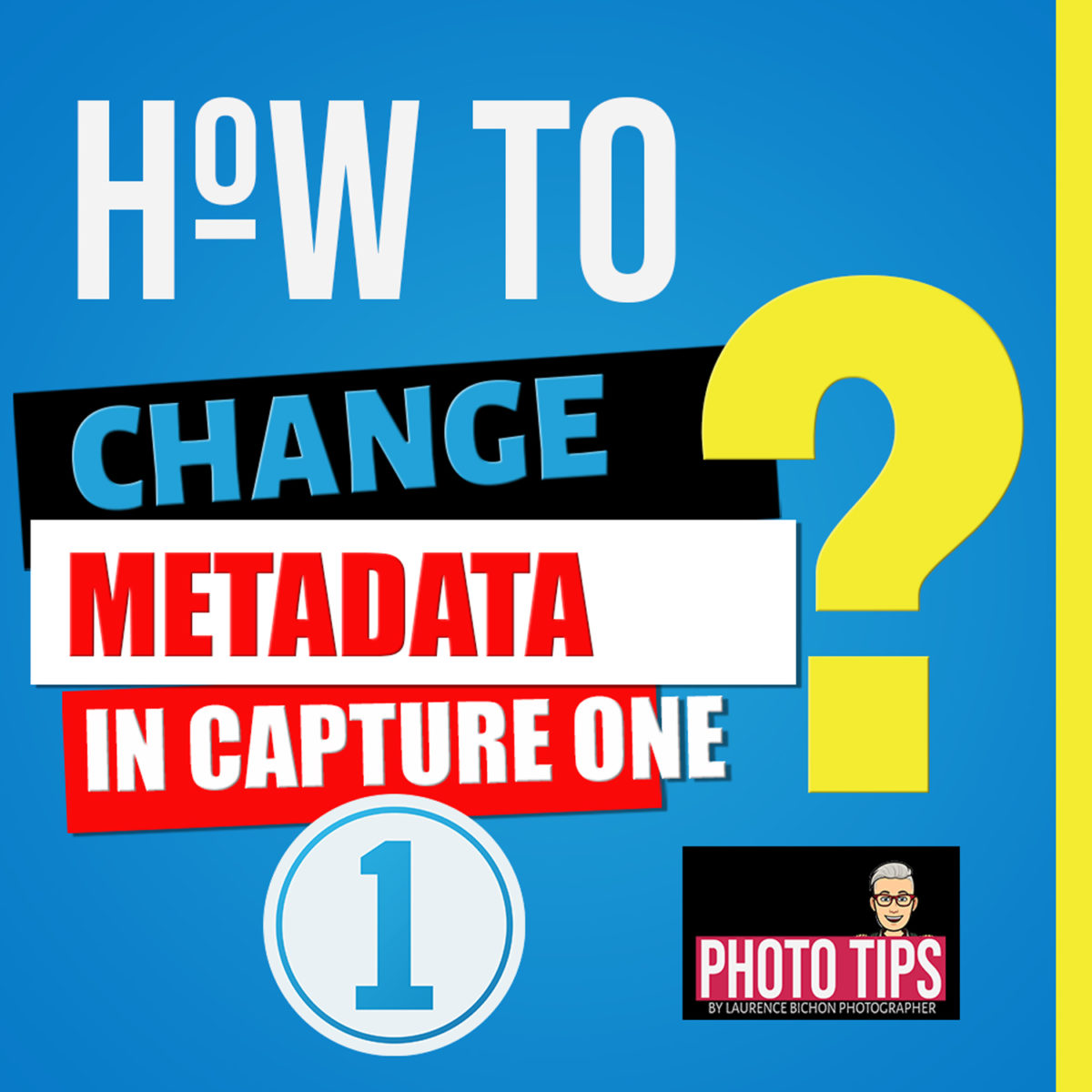In Capture one, many tools may impact the metadata of an image. Sometimes, this is not obvious. This is why I started to list tools and found 7 ways to change metadata in Capture One Pro.
The 7 ways to change your image metadata in Capture One Pro are when importing the image, when manually editing the metadata, when applying styles or metadata presets, when copying adjustments, when creating a new variant, when filtering metadata in the export recipe.
3 – When applying a Keywords or a Metadata Preset
5 – When Creating a New Variant for the image
7 – Metadata tab in the Export Recipe
1 – When Importing the image
In the import dialog, you can modify your metadata in three ways :
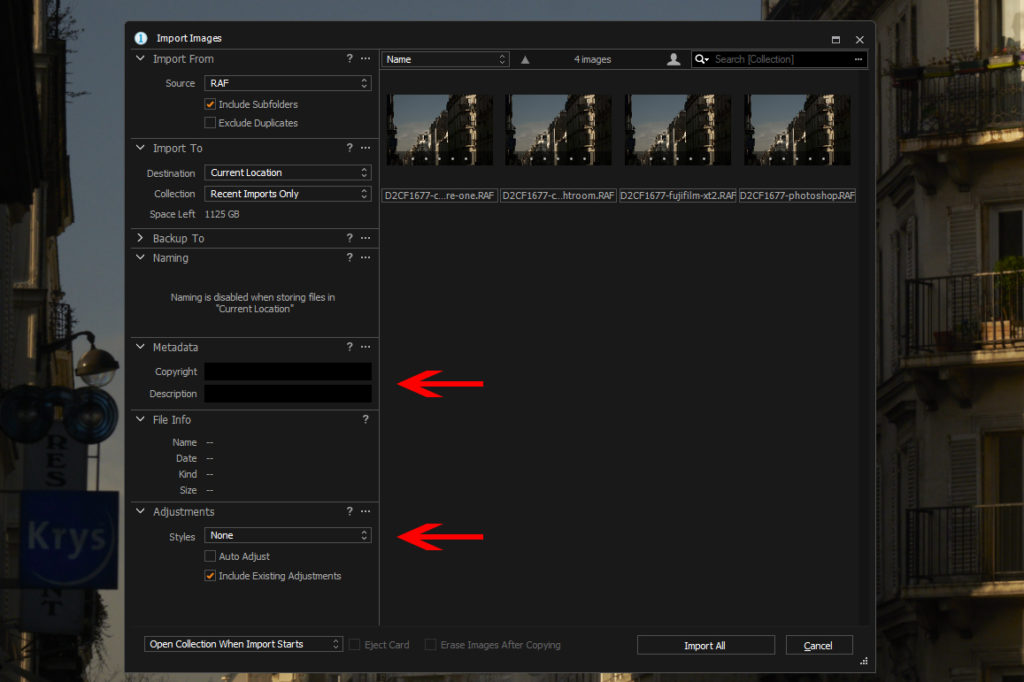
About the metadata Copyright and Description :
| C1 Import Panel | C1 Metadata Panel | XMP specification |
| Copyright | [IPTC – Status] Copyright Notice | [XMP-dc] Rights |
| Description | [IPTC – Content] Description | [XMP-dc] Description |
2 – In the Metadata Window
This windows is the main Capture One windows when you can see and change the keywords (Keywords tool) and metadata (Metadata tool) of the image.
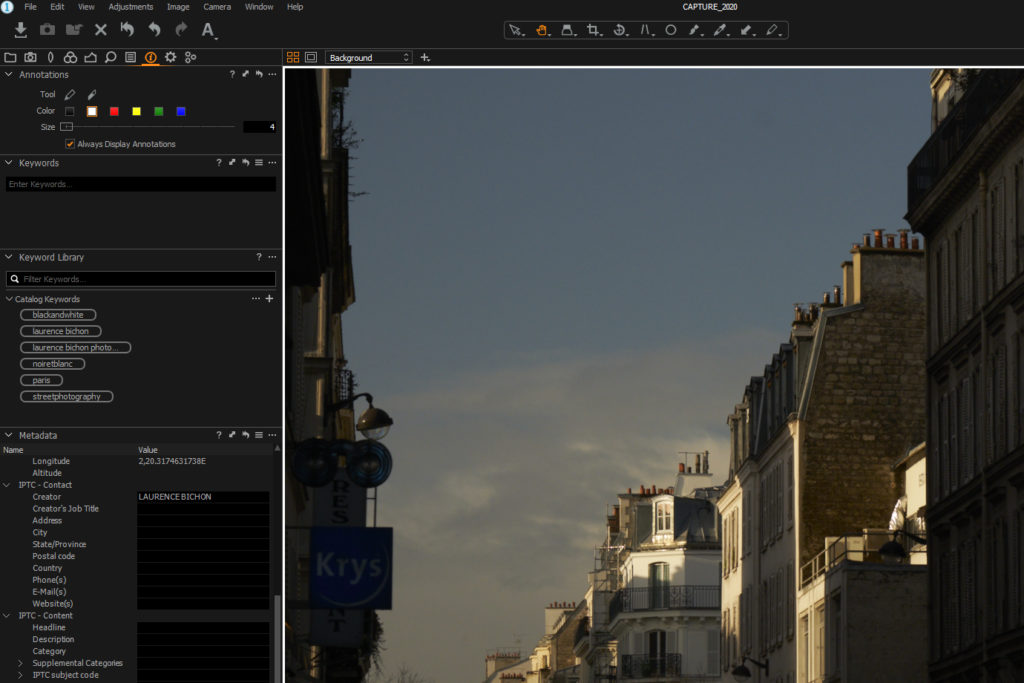
3 – When applying Keywords or Metadata Presets
You can predefine lists of metadata in Metadata Presets, and lists of keywords in Keywords Presets. You can then choose to apply at once all these parameters to an image.
You’ll deal with keywords and metadata presets in :
- Keywords tool (define and apply)
- Metadata tool (define and apply)
- Styles and Presets tool (apply)
Metadata presets do not include keyword presets.
How to create a preset ? Change the metadata or keywords for an image, then go in the Metadata or Keywords Tool and click on the 3 little bars on the upper right corner of the tool, then save preset.
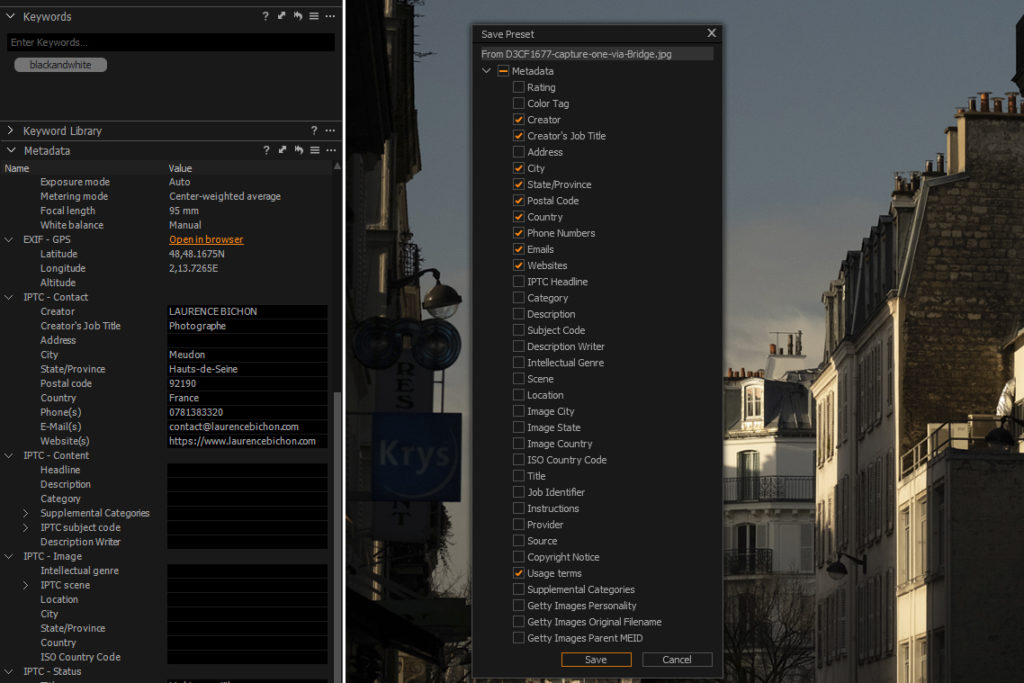
If you want to see or change a preset, there is no dedicated interface, you can create a totally metadata & keywords free image, then load the keyword or metadata preset. Then you’ll see the content of this preset. If you want to update it, change the values for this image, then update the preset.
Keyword Presets are stored as XML files by default in C:\Users\admin\AppData\Local\CaptureOne\Presets60\Keywords.
<?xml version="1.0"?>
<SL Engine="1100">
<E K="Content_Keywords" V="blackandwhite||0" />
<E K="Name" V="my-keyword-preset" />
<E K="StyleSource" V="Keywords" />
<E K="UUID" V="AEAC2DA6-7B25-4320-8F3C-D97C69EE714D" />
</SL>Metadata Presets are also stored as XML files, but in C:\Users\admin\AppData\Local\CaptureOne\Presets60\Metadata.
<?xml version="1.0"?>
<SL Engine="1100">
<E K="Contact_City" V="Meudon" />
<E K="Contact_Country" V="France" />
<E K="Contact_Creator" V="LAURENCE BICHON" />
<E K="Contact_CreatorsTitle" V="Photographe" />
<E K="Contact_Websites" V="https://www.laurencebichon.com" />
<E K="Name" V="Metadata_LaurenceBichon" />
<E K="StyleSource" V="Metadata" />
<E K="UUID" V="5DDF722A-AD8C-467D-AC85-B4D440242E8D" />
</SL>
Stack Presets
Without the stacking option you can only apply one Preset to each image. Applying a second one removes the first preset.
You can decide to stack presets at the tool level. By default, the “Stack Presets” is turned off.
For instance, you can decide to stack Presets for the tool Metadata but not for the tool Keywords. For me, stack Presets are off for Keywords and Metadata.
See Capture One Documentation on Stack Presets if needed on this option.
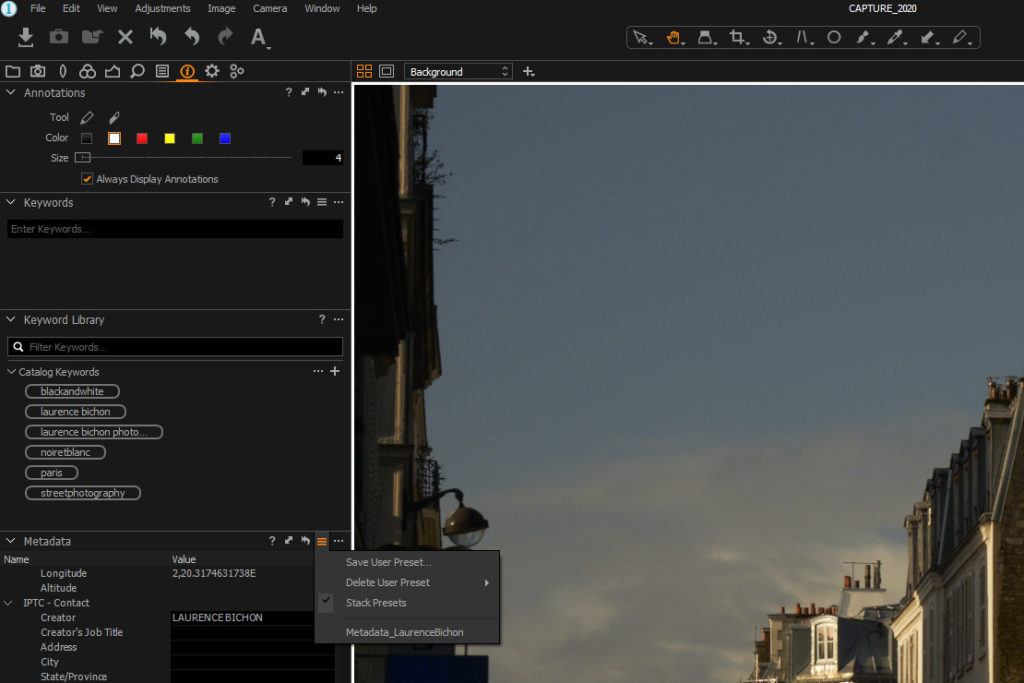
4 – When applying a Style
A style may contain metadata information.
If you apply a style that contain metadata info, the metadata will be changed for this image.
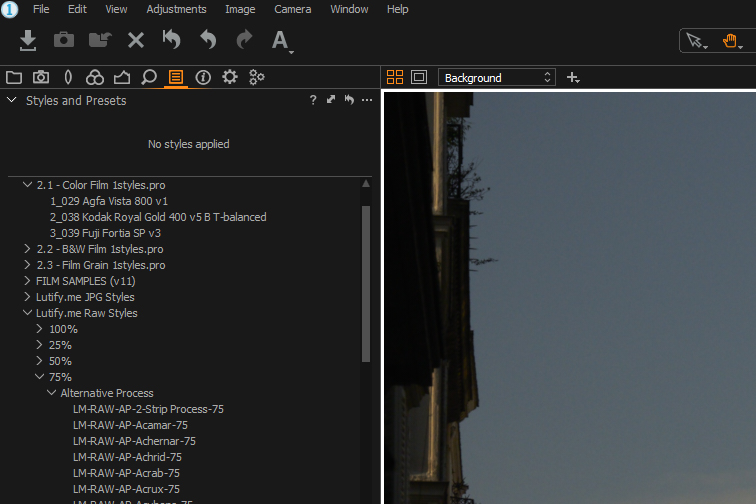
Stack Styles
Without the stacking option you can only apply one Style only to each image. Applying a second one removes the first style.
You can turn Stack Styles on and off :
- in the Styles and Presets tool, 3 dots menu on the upper right corner, Stack Styles.
- Adjustments > Styles > Stack Styles
Once you stacked styles in your image, they remain stacked until you remove one of them, independantly of the “Stack Styles” option. This option is used only when the style is applied.
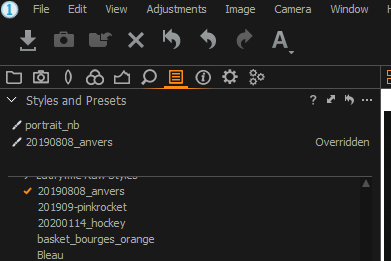
See Capture One Documentation on Stack Styles if needed on this option.
You can stack styles, if this option is enabled.
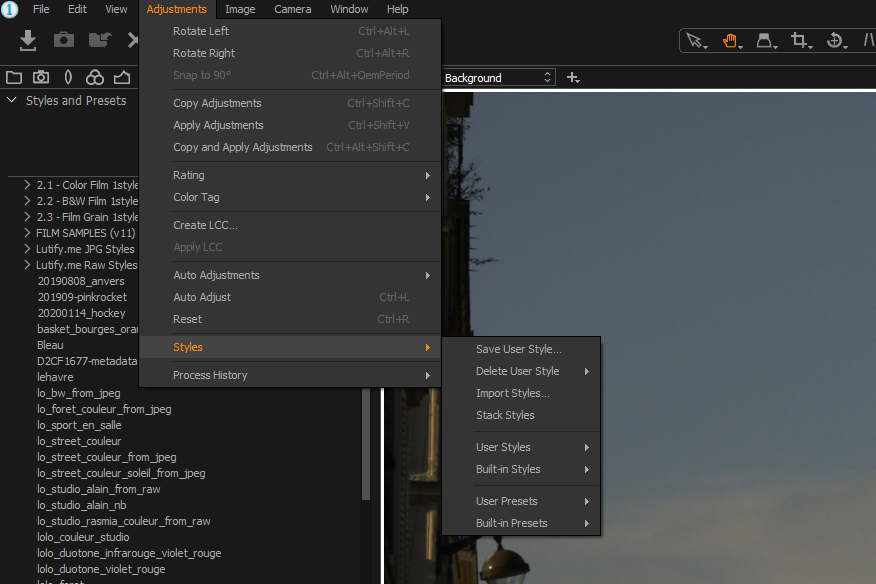
5 – When Creating a New Variant for the image
When you create a new variant of an image : select the image, right click, then Create new variant.
In a new variant, the metadata are reseted, except for the Exif data (the camera creates the Exif metadata when creating the image file, JPEG or RAW).
When you create a clone variant of an image on the contrary, metadata are copied.
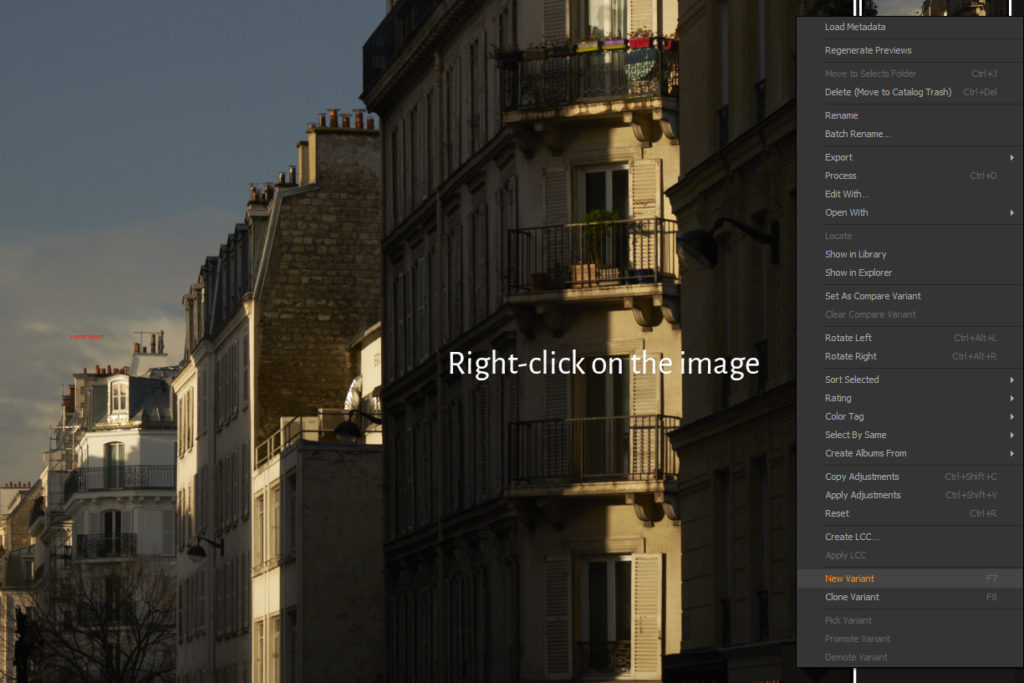
Note that the Reset of an image (Ctrl R) does not reset the metadata of an image.
6 – Copy/Paste Adjustments
In order to copy the Adjustments of an image, select the image then right click and select Copy Adjustments.
Then go to the Adjustments Clipboard Tool in the Info Window to select which metadata of the origin image will be copied to the target image.
Beware that keywords are under metadata in the Adjustment Clipboard tree. You can select them for copy or not in the Adjustments Clipboard.
In my Capture One 11 version, metadata are not selected by default for an Adjustment copy, even if the origin image has metadata.
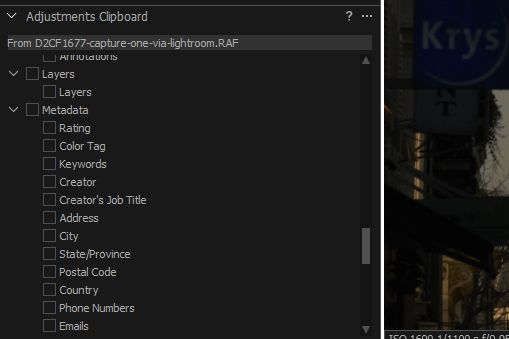
7 – Metadata tab in the Export Recipe
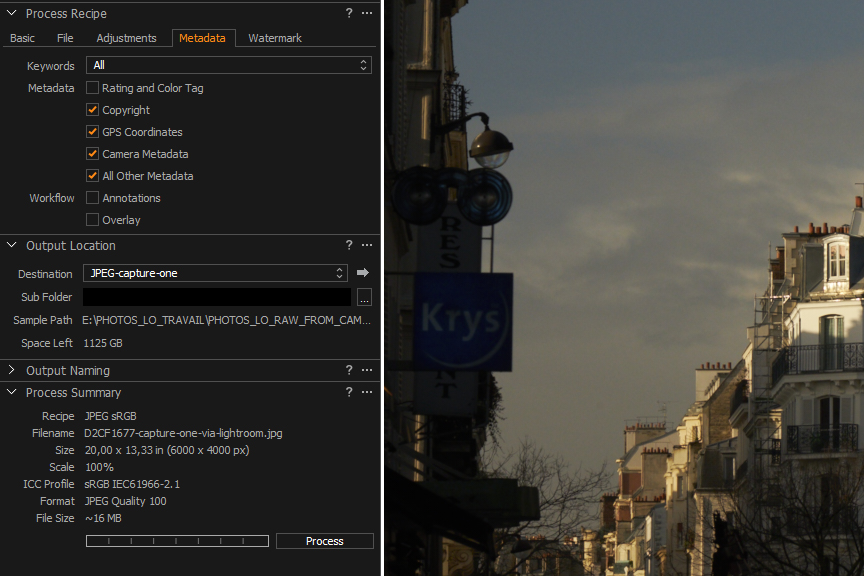
In the metadata tab, you can choose to export or not metadata by types in the JPEG or TIFF :
- Copyright
- GPS Coordinates
- Camera Metadata
- All Other Metadata
Remove Camera Metadata from an image
If you select “Camera Metadata” in your receipe, you will remove the Exif metadata from the image.
Some people do not want to expose their camera brand, their shooting settings, or their camera or lens’ serial number.
Your can remove Exif metadata from the exported file. However, note that it’s an all or nothing operation. You cannot select some Exif to keep and some Exif to remove. If you want to be more selective, you could use a tool like exiftool by Phil Harvey.
Here is the Exif metadata section of an image as generated by my Fujifilm Camera:
---- IFD0 ----
Image Description : [IPTC - Content] Description
Make : FUJIFILM
Camera Model Name : X-T2
X Resolution : 300
Y Resolution : 300
Resolution Unit : inches
Software : Capture One 11.1.1 Windows
Artist : [IPTC - Contact] Creator
Copyright : [IPTC - Status] Copyright Notice
---- ExifIFD ----
Exposure Time : 1/1100
F Number : 9.0
Exposure Program : Aperture-priority AE
ISO : 1600
Sensitivity Type : Standard Output Sensitivity
Exif Version : 0230
Date/Time Original : 2020:02:11 10:45:42
Create Date : 2020:02:11 10:45:42
Shutter Speed Value : 1/1100
Aperture Value : 9.0
Brightness Value : 6.54
Exposure Compensation : -1
Max Aperture Value : 3.5
Metering Mode : Center-weighted average
Light Source : Shade
Flash : No Flash
Focal Length : 95.0 mm
Exif Image Width : 6000
Exif Image Height : 4000
Focal Plane X Resolution : 820
Focal Plane Y Resolution : 820
Focal Plane Resolution Unit : cm
Sensing Method : One-chip color area
File Source : Digital Camera
Scene Type : Directly photographed
Custom Rendered : Normal
Exposure Mode : Auto
White Balance : Manual
Focal Length In 35mm Format : 143 mm
Scene Capture Type : Standard
Sharpness : Normal
Subject Distance Range : Unknown
Serial Number : 73M58112
Lens Info : 95mm f/3.482202254
Lens Make : FUJIFILM
Lens Model : XF55-200mmF3.5-4.8 R LM OIS
Lens Serial Number : 77A10894Then I selected to remove the camera metadata in Capture One, and the Exif section become :
---- IFD0 ----
Image Description : [IPTC - Content] Description
X Resolution : 300
Y Resolution : 300
Resolution Unit : inches
Software : Capture One 11.1.1 Windows
Artist : [IPTC - Contact] Creator
Copyright : [IPTC - Status] Copyright Notice
---- ExifIFD ----
Exif Version : 0221
Exif Image Width : 6000
Exif Image Height : 4000Note that if you customized Author and Copyright in your Fujifilm Camera, these information are kept in the image even with the option “remove the camera metadata” checked in Capture One.
Capture One Training Video
Here is a video on how to work with metadata in Capture One, you may have a look at Working with Keywords and Metadata with David Grover.
Conclusion
We’ve reached the end of this post on 7 Ways To Edit Metadata in Capture One Pro.
If you wish more information related to metadata and Capture One Pro, you could read :
- The Photographer’s Metadata Survival Guide
- How To Add A Copyright In Capture One Pro – In Depth Review
Q&A
Is it possible to add GPS / Geo Tagging ?
The Capture One interface allow you to read the latitude and longitude metadata of an image. However, it does not allow you to modify them or set them if them are not defined.
Can I import in Capture One the metadata I updated in Lightroom CC ?
Yes you can import your Lightroom metadata in Capture One.
If Capture One supports those metadata, you will read them and be able to modify most of them in Capture One.
If Capture One does not support them, it depends. Sometimes metadata from the imported file can be passed over to the outpt file even if it is nit supported by CA. For instance with the XMP Licensor metadata. Be cautious as this may change over time. This is why I prefer to set metadata that are not already supported by C1, after the generation of the output file.
When importing an image, Capture One uses the metadata stored in the image file and if it exists in the .xmp sidecart file.
For example, you can edit a .RAF raw Fuji file in Lightroom : keywords, a Title, geo coordinates. Lightroom will create a sidecart .xmp file. When you import the image in Capture One, the metadata will be read.
Capture One works with a catalog and the original image, plus a possible .xmp sidecart file. You can customize the usage of embedded metadata over sidecart, the synchronization process in Edit > Preferences > Metadata.
I will not dig into this, because I do not want to interfere in the way Capture One deals with its catalog. What is important to me is that my exported file contains embedded metadata.
Here is Capture One documentation about the storage of metadata in the image.
